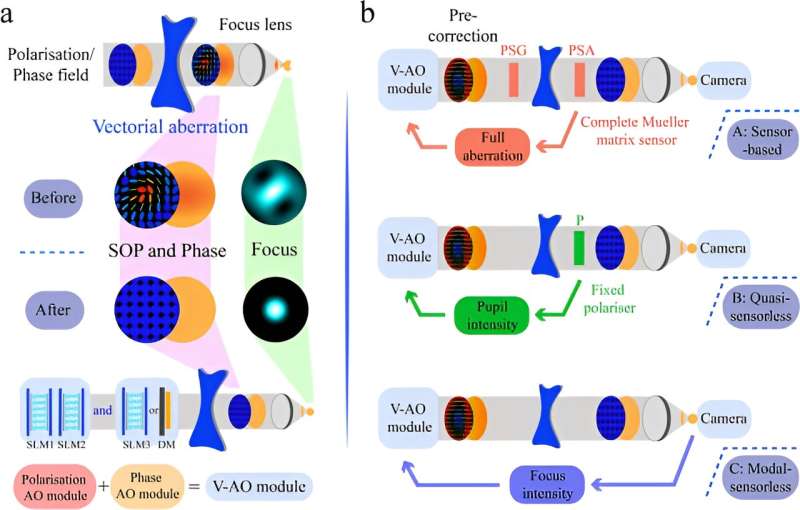Vectorial aberrations, vectorial adaptive optics (V-AO), and correction methods ranging from sensor-based to sensorless. Credit: eLight (2023). DOI: 10.1186/s43593-023-00056-0
Adaptive optics (AO) is a technique used for real-time correction of phase aberrations by employing feedback to adjust the optical system. Polarization aberrations represent another significant type of distortion that can impact optical systems. Various factors, such as stressed optical elements, Fresnel effects, and polarizing effects in materials or biological tissues, can induce polarization aberrations. These aberrations affect both system resolution and the accuracy of vector information.
Vectorial aberrations result from the combined effects of phase and polarization aberrations. They can substantially influence the performance of many modern optical systems, especially those sensitive to vectors or requiring high resolution. For example, in lithographic systems, polarization aberrations play a crucial role in systematic resolution, affecting the quality of the manufactured chips.
In eLight a team of scientists, led by Dr. Chao He from the University of Oxford, has introduced a next-generation AO technique termed vectorial adaptive optics (V-AO). This technique aims to enhance both the uniformity of the vector field state and the optical resolution of an optical system.
V-AO is an innovative technique designed to correct both polarization and phase aberrations. It stands as a powerful tool capable of improving the performance of various optical systems, including microscopes, telescopes, and laser systems. This advancement offers new insights into cutting-edge biomedical imaging, planetary observation, and the manufacturing of integrated circuit chips.
The authors of the paper outline three distinct methods for implementing V-AO: sensor-based, quasi-sensorless, and modal-sensorless. They also present experimental results showcasing the effectiveness of V-AO in correcting common vectorial aberrations.
V-AO represents a promising and innovative technology poised to revolutionize the optics community. Its potential lies in enhancing the performance of optical systems and enabling new applications.
Through vectorial field feedback control methods, this next-generation AO technique is expected to benefit various research areas, ranging from astronomical telescopes to microscopy. Its applications extend from galaxy detection to laser-based and lithographic nanofabrication, as well as biomedical and clinical characterization.
More information: Chao He et al, Vectorial adaptive optics, eLight (2023). DOI: 10.1186/s43593-023-00056-0
Journal information: eLight
Provided by Chinese Academy of Sciences
























